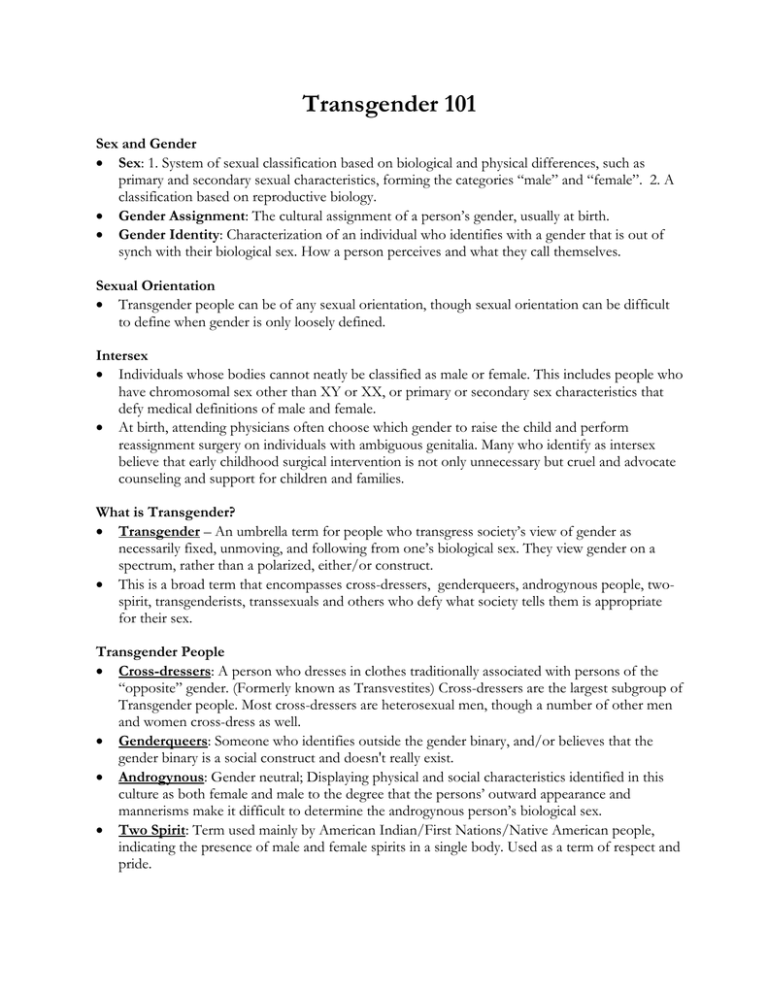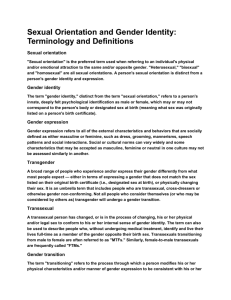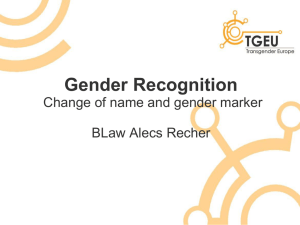
Transgender 101
Sex and Gender
• Sex: 1. System of sexual classification based on biological and physical differences, such as
primary and secondary sexual characteristics, forming the categories “male” and “female”. 2. A
classification based on reproductive biology.
• Gender Assignment: The cultural assignment of a person’s gender, usually at birth.
• Gender Identity: Characterization of an individual who identifies with a gender that is out of
synch with their biological sex. How a person perceives and what they call themselves.
Sexual Orientation
• Transgender people can be of any sexual orientation, though sexual orientation can be difficult
to define when gender is only loosely defined.
Intersex
• Individuals whose bodies cannot neatly be classified as male or female. This includes people who
have chromosomal sex other than XY or XX, or primary or secondary sex characteristics that
defy medical definitions of male and female.
• At birth, attending physicians often choose which gender to raise the child and perform
reassignment surgery on individuals with ambiguous genitalia. Many who identify as intersex
believe that early childhood surgical intervention is not only unnecessary but cruel and advocate
counseling and support for children and families.
What is Transgender?
• Transgender – An umbrella term for people who transgress society’s view of gender as
necessarily fixed, unmoving, and following from one’s biological sex. They view gender on a
spectrum, rather than a polarized, either/or construct.
• This is a broad term that encompasses cross-dressers, genderqueers, androgynous people, twospirit, transgenderists, transsexuals and others who defy what society tells them is appropriate
for their sex.
Transgender People
• Cross-dressers: A person who dresses in clothes traditionally associated with persons of the
“opposite” gender. (Formerly known as Transvestites) Cross-dressers are the largest subgroup of
Transgender people. Most cross-dressers are heterosexual men, though a number of other men
and women cross-dress as well.
• Genderqueers: Someone who identifies outside the gender binary, and/or believes that the
gender binary is a social construct and doesn't really exist.
• Androgynous: Gender neutral; Displaying physical and social characteristics identified in this
culture as both female and male to the degree that the persons’ outward appearance and
mannerisms make it difficult to determine the androgynous person’s biological sex.
• Two Spirit: Term used mainly by American Indian/First Nations/Native American people,
indicating the presence of male and female spirits in a single body. Used as a term of respect and
pride.
•
•
•
•
Transgenderists: A person who elects to not have Sexual Reassignment Surgery (SRS), but lives
part-time or full-time as a member of the opposite sex and may or may not use hormones.
Transsexual: A person whose gender identity is opposite their assigned sex. Transsexuals may
live as the “opposite” sex, undergo hormone therapy, and/or have sex reassignment surgery to
match their bodies with their gender identity.
Female to Male (FTM)
Male to Female (MTF)
Transition
• Questioning
• Identity Formation
• Living as the “opposite” sex
• Hormones
• Sexual Reassignment Surgery
• All transsexuals approach transition differently. Each has his or her own reasons for using or
not using hormones and for deciding whether or not to have surgery.
Female to Male Transsexuals
Hormones: Testosterone
• Deepening voice
• Breast atrophy
• Hair growth on face, chest, and extremities
• Menstruation stops
• Redistribution of fat and muscle
• Also, acne, infertility, cholesterol and liver problems, and male pattern baldness
Surgeries:
• “Top” surgery
o “Keyhole”- breast liposuction (for small breasts)
o Double Mastectomy (often incl. nipple grafts)
• “Bottom” surgery
o Hysterectomy
o Metoidioplasty (clitoral release)
o Phalloplasty (construction of a penis from a skin graft)
o Scrotoplasty (creation of a scrotal sac and testicular implants)
Male to Female Transsexuals
Hormones: Anti-androgen and Estrogen
• Breast growth
• Redistribution of body fat to female figure
• Decreased upper body strength
• Softening of skin
• Decrease in body hair
• Slowing or stopping loss of scalp hair
• Decreased fertility and testicular size
•
There are many possible adverse effects of estrogen including decreased libido, circulatory
system problems, and increased cancer risk.
Surgery:
• “Top” Surgery
o Breast implants
• “Bottom” Surgery
o Penectomy and Orchiectomy (removal of penis and testicles)
o Vaginoplasty (Removal of male organs and construction of vaginal cavity, labia and
clitoris)
• Other surgeries
o Facial reconstruction, rhinoplasty, face-lift
o Adam’s apple shaving
o Waist lipoplasty
Transsexual Health Care Costs
• Most health insurance companies consider sex reassignment surgery cosmetic, and as a result, do
not cover it.
• Most transsexuals must cover the entire cost of hormones and Sex Reassignment Surgery out of
pocket.
• Surgeries range from $3,500 to $100,000.
How are Trans People Discriminated against?
Gender Identity is not protected in most anti-discrimination laws and policies
• Restrooms
• Jobs
• Housing
• Health care
• Homeless shelters
• Anti-transgender violence
What is Transphobia?
• Transphobia is the fear of a transgender person and the hatred, discrimination, intolerance,
and prejudice that this fear brings.
• Transphobia is manifested as harassment, threatened safety, disgust, ridicule, restrictions on
freedom of movement, restrictions on access to resources (housing, employment, services
etc), and violence to name a few.
How do I treat a Transgender Person?
• Treat transgender people with the same respect you treat others.
• If you are not sure how to address them, it is better to ask than assume!
• Make an effort to use the person’s preferred name and pronouns.
• Don’t ask questions about their genitals or how they have sex, unless they have indicated
that it is ok!









